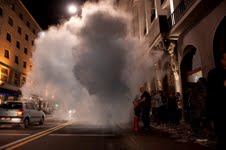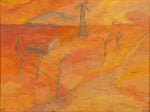The Present and Presence Repetition 2

Mostra collettiva
Comunicato stampa
The series of Repetition exhibitions at the MSUM underscores various specific concepts of time by giving emphasis to different selections of works from the Moderna galerija collections; the latest version thus focuses on movement. In physics, motion is any change in position of an object with respect to time. In art, we speak of movements and currents in various historical periods, but no longer in terms of linear sequences or developments, that is to say, there is no longer a single, universal standpoint from which to observe them. What is significant in understanding art today is that it can be observed through the prism of “time that liberates,” which can be either the view that opposes the dominant understanding of time or the view that provides a different conception of our presence in the world. It is such an active view that constitutes movement.
Repetition 2 includes works that could be described as cinematic in some way. They are images about motion and in motion, and more than that: they are works that question the idea of film, the nature of film as a medium, of the “moving images,” and also emphasize various active views in art that trigger a different attitude to time, images and, above all, thinking itself. Here thinking can be understood as an experience of intensity beyond the established categories of the known.
Philosopher Henri Bergson was the first to speak of moving images with regard to film, emphasizing the need for new ways of thinking about cinematography. His three ideas concerning motion are important: the first one speaks about motion as an indivisible action in which space is divisible; the second one says that the new ways of thinking about motion derive from modern science, which has introduced time as a specific variable, thereby returning motion to the realm of ordinary moments, rather than privileged ones; and the third one comprises the premise that motion expresses something deeper, which in cinematography means that an image is more than merely an image in motion, becoming instead a movement-image. These ideas were later used as points of departure by Gilles Deleuze when he said that thoughts were inseparable from images and that the language of cinematography was in the first place about extracting thoughts without abstracting them; in short, that thought processes were based on images.
It is a well-known hypothesis that the visual culture of our era remains cinematic despite the technological progress. But if, as Tomislav Gotovac would say, everything is a film, if we watch a film from the moment we open our eyes in the morning – when does the break occur, the break that enables the beginning of an idea? Or more precisely: an idea that forces us to think, thus separating us from the uninterrupted flow of images filling our everyday visual experiences? In other words: when does the structure of scenes become so dense that only individual images and thoughts in motion remain?



